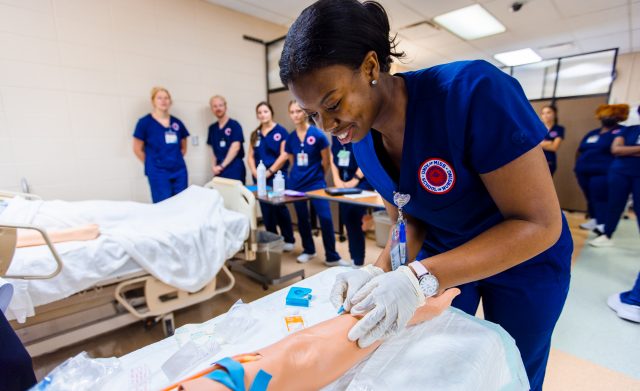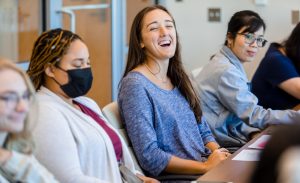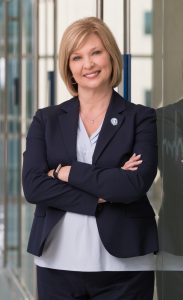
School of Nursing student Maya Anderson inserts a peripheral IV into a manikin arm as part of the school’s skills relay exercise at UMMC’s Simulation and Interprofessional Education Center in the Medical Education Building. The school recorded an enrollment rise of 4% for the fall, second-highest rate among campus schools. Photo courtesy UMMC
JACKSON, Miss. – For the fourth consecutive year, campus schools at the University of Mississippi Medical Center are marking a jump in overall enrollment.
At 3,098, the figure for fall 2022 surged 1.4% over the record-breaking year of 2021.
Released by the Mississippi Institutions of Higher Learning, the numbers capture six Medical Center schools – all but pharmacy, whose share is part of the official count for the University of Mississippi‘s School of Pharmacy in Oxford.
“We are thrilled to see the continuous growth of our academic programs,” said Natalie Gaughf, the Medical Center’s assistant vice chancellor for academic affairs. “With every graduate, we advance the mission of UMMC and improve the health of patients and the community.
“Changes in enrollment are anticipated as we grow and fine-tune our academic programs in response to the workforce needs in Mississippi.”
This expansion defies a national trend: The National Student Clearinghouse Research Center reported in October that the graduate tally fell by 1%, while a second successive decrease in the undergraduate roster equaled a 4.2% drop since 2020.
Dr. LouAnn Woodward, vice chancellor for health affairs at UMMC, is encouraged by the upswing despite the pandemic-induced pressures on health care since 2020.
“We continue to see sustained levels and, in some schools, significant increases in our student enrollment,” Woodward said. “This tells me that our mission to create a healthier Mississippi is resonating with those who seek careers as caregivers and scientists in our state, and we are proud of our role in producing health professionals as the state’s only academic medical center.”
The John D. Bower School of Population Health, which was launched in 2016, swelled by 17.8%, the highest rate among the schools; 53 students, including residents and fellows, are enrolled.
“This school is a relatively new addition to UMMC, but it’s growing in students and impact,” said Dr. Thomas Dobbs, professor of population health, who was appointed dean of the school in August.
“I expect to see great things in regard to research, education and community impact over the next few years.”
With 850 students, the School of Nursing also documented a healthy boost: 4%. “The School of Nursing continues to be responsive to the needs for the nursing workforce in our state,” said Julie Sanford, professor of nursing and dean of the school.
“While the demand for education in our advanced nursing tracks continues, our pre-licensure programs have experienced the greatest growth as we are striving to educate more new nurses.
“Another program that has seen significant growth is the nurse educator program. We are encouraged to see the interest in becoming a nurse educator grow as Mississippi is experiencing a significant shortage of nursing faculty.
“Our associate dean of academic affairs, Dr. Joe Tacy, jokingly calls this our ‘sardine enrollment.’ We are maxed out in our spaces at the Jackson campus.”
The School of Dentistry also showed an upturn: 1.5%, even though the number of students accepted is locked in for now.
“At our School of Dentistry, we continue to be most grateful for the quality of our dental students and our dental hygiene students,” said Dr. Sreenivas Koka, professor and dean of the school, which is educating 200 students this fall.
“Our students embody a special blend of humility, grace, natural intelligence, work ethic and fun.”

Erinn Funches (left), Taylor Ward and Tran Le, all students in the UM John D. Bower School of Population Health, attend the first SOPH student body meeting in September. The school registered the highest rate of enrollment growth this fall on the UMMC campus: 17.8%. Photo courtesy UMMC
The School of Medicine claims 657 students; including residents and fellows, the total count is 1,292, representing an overall dip of 0.7% compared to 2021. The drop for medical students alone is only 0.2%, with a loss of just one student. Like the dental school, the medical school accepts a limited number of students each year.
“While we were excited and energized with the record number of applicants to medical school a year ago, it is sobering to look at the decline this year,” said Dr. Loretta Jackson-Williams, professor of emergency medicine and vice dean for medical education in the School of Medicine.
“There is no doubt there are many factors which contribute to the decline including those related to the pandemic such as changes in the collegiate educational programs for students as well as significantly altered personal circumstances for students.
“Regardless, in the School of Medicine, we are committed to our outreach programs, which offer students interested in medicine opportunities to explore medicine and all of its possibilities. We will do everything we can to prepare them for the profession.”
Two other Medical Center schools recorded decreases.
After a 4.3% jump in 2021 over the previous year, the School of Graduate Studies in Health Sciences slipped this fall by 3.1%, collecting 220 students.
“We are delighted to hit our target enrollment despite recruitment challenges as a result of the pandemic,” said Joey Granger, Billy S. Guyton Distinguished Professor, professor of physiology and medicine, and dean of the SGSHS.
“We continue to see an increase in quality applicants and outstanding students entering our M.S. and Ph.D. programs.”
With 451 students, the School of Health Related Professions saw a fall-off of 2%.
“We are proud that enrollment in our SHRP programs has remained steady despite challenges to effectively recruit for the past several years,” said Angela A. Burrell, associate professor and chair of the Doctor of Health Administration Program and the school’s interim dean.
“We did experience a slight decline in our online programs which was anticipated since most of these students work full-time in health care settings and had unprecedented competing priorities during the COVID-19 pandemic.”
